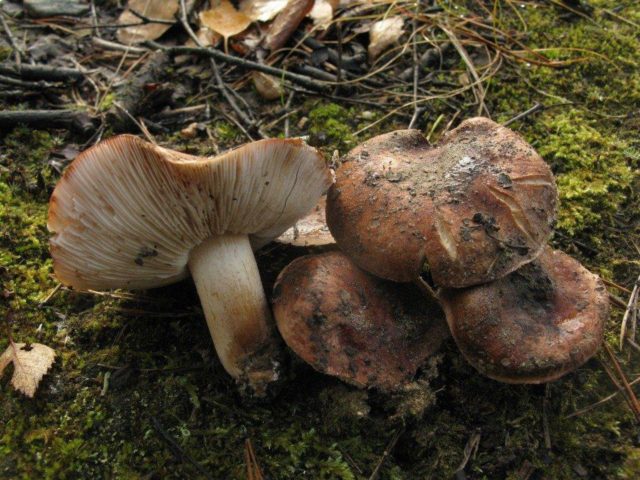Content
White pig gentian has several synonymous names: white pig gentian, leucopaxillus gentian. Previously, another name was used for the mushroom: Leucopaxillus amarus.
Where does white pig gentian grow?
The mushroom is not widespread: in addition to Russia, it grows in small quantities in Western Europe and North America. The main habitat is deciduous plantings rich in calcareous soil.

Most often found in old spruce forests and other coniferous plantations, where it forms “witch circles”
The mushroom can grow either in groups or singly. The main fruiting period lasts from the last week of June to the beginning of September.
What does the white pig gentian look like?
The cap of the fruiting bodies has a diameter of 4 to 12 cm. In some specimens this figure is 20 cm.In young specimens, the cap is hemispherical; as it matures, it straightens out: it becomes convex or flat-convex. In some fruiting bodies it is flat-spread, with a depression in the center.
The color changes depending on the maturity of the mushroom: young specimens are reddish-brown, darkening in the middle.

At the end of the fruiting period, the cap turns pale, acquiring an orange-yellow or white hue.

Some of the specimens have cracks, their edges are slightly curled
The plates are narrow, descending in shape, and often located. They are white or creamy in color. Some specimens have yellowish plates with red-brown spots or stripes.

The leg reaches 4.5 cm in length, smooth, but with a thickened base, white in color with flakes on the surface
The flesh of Leucopaxillus is yellowish-white in color and has a pungent, mealy aroma. It tastes very bitter.
The twin of the white gentian is the scaly row. The mushroom is fleshy, its flesh is white and dense, and has a mealy smell. The cap of the row is from 4 to 8 cm in diameter, round or bell-shaped with rolled edges. It has a matte surface with scales, reddish-brown in color with a reddish center. The leg is cylindrical, slightly curved.

Scaly row grows in mixed forests or in coniferous plantings, giving preference to pine trees
The double is edible; in some sources it is indicated as conditionally edible or inedible. The inconsistency of information is due to the lack of knowledge of the species.
It has an external resemblance to the white-brown gentian and the white-brown row.It has a hemispherical or convex-spread cap with a fibrous skin, which cracks over time and creates the appearance of scales. The color ranges from brown with an admixture of chestnut to brownish. There are lighter specimens. The plates are frequent, white interspersed with a reddish-brown tint.

The stem of young representatives is white, but as the fruiting bodies mature, it changes color to brown
The mushroom is conditionally edible and requires soaking and boiling before use. In foreign sources it is classified as inedible.
Unlike the white pig gentian, the double's flesh under the skin has a red-brown tint and is not bitter in taste.
Is it possible to eat white pig gentian?
Fruiting bodies are classified as inedible, but not poisonous. They are not eaten because of their taste: the flesh is very bitter.
Conclusion
White gentian is a beautiful, large, but inedible mushroom. It grows in coniferous plantations. The fruiting period is from July to September.








